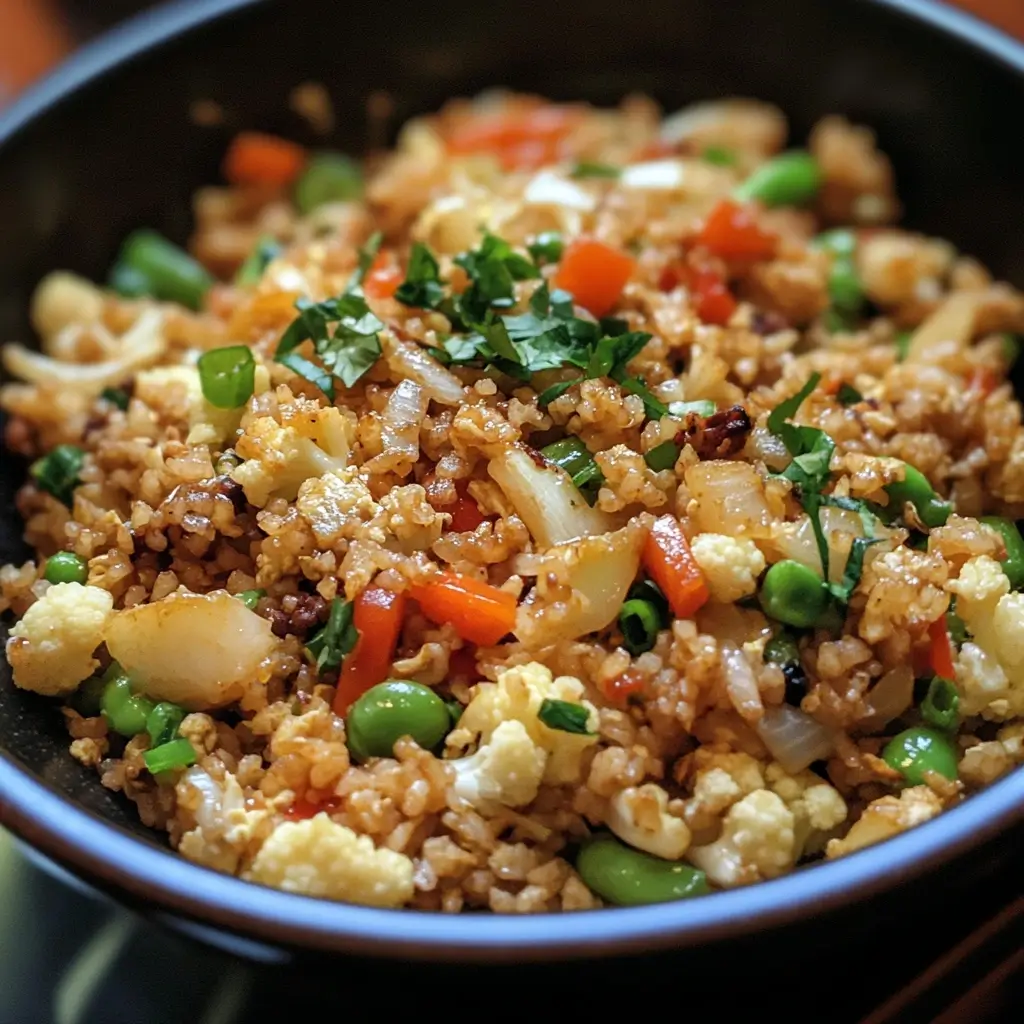I have to be honest, the first time someone suggested replacing fluffy, comforting white rice in a stir-fry with cauliflower, I was skeptical. Really skeptical. Rice is practically the soul of a stir-fry, right? How could blitzed vegetables possibly compare? But facing a family dinner dilemma – needing something fast, healthy, and appealing to both adults trying to eat low-carb and kids who suspiciously eye anything green – I decided to give Cauliflower Stir-Fry Rice a shot. The result? Astonishingly delicious. The cauliflower “rice” soaked up the savory, gingery sauce beautifully, maintaining a slightly firm, satisfying texture that wasn’t mushy at all. It was vibrant with colorful veggies, packed with flavor, and came together in under 30 minutes. My husband, initially wary, went back for seconds. Even the kids, surprisingly, cleared their plates without complaint, picking out their favorite bits of carrot and bell pepper. It’s since become a regular in our weeknight rotation. It’s proof that healthy eating doesn’t mean sacrificing flavor or satisfaction, and it’s incredibly versatile, allowing us to use up whatever veggies we have lurking in the fridge. This Cauliflower Stir-Fry Rice isn’t just a substitute; it’s a genuinely fantastic dish in its own right, and I’m excited to share how you can make this quick, flavorful, and surprisingly satisfying meal a star in your kitchen too. It feels light yet filling, and knowing it’s packed with nutrients makes it taste even better.
Ingredients
Here’s what you’ll need to create this vibrant and healthy Cauliflower Stir-Fry Rice:
- 1 large head Cauliflower (about 2-2.5 lbs): This is the star, replacing traditional rice. You’ll rice it yourself for the best texture.
- 1 tablespoon Coconut Oil or Avocado Oil: A high smoke point oil, perfect for stir-frying.
- 2 cloves Garlic (finely minced): Provides a pungent, aromatic base flavor essential to stir-fries.
- 1 tablespoon Ginger (freshly grated or finely minced): Adds warmth, spice, and that characteristic stir-fry zing.
- 1 medium Yellow Onion (thinly sliced or diced): Adds a layer of sweetness and depth when sautéed.
- 1 large Carrot (peeled and julienned or thinly sliced): Adds sweetness, color, and a pleasant crunch.
- 1 Red Bell Pepper (deseeded and chopped): Provides sweetness, vibrant color, and essential vitamins.
- 1 cup Frozen Peas (thawed): Adds pops of sweetness and green goodness; convenient and quick to cook.
- 1/2 cup Broccoli Florets (cut small): Adds earthy notes, texture, and a boost of nutrients. Ensure they are small for quick cooking.
- 3 large Eggs (lightly beaten – optional, for non-vegan): Adds protein and richness, creating pockets of scrambled egg throughout.
- 1/4 cup Low-Sodium Soy Sauce or Tamari (for gluten-free): The primary source of savory, umami flavor. Use Tamari or Coconut Aminos for strict gluten-free/paleo.
- 1 tablespoon Toasted Sesame Oil: Adds a distinct nutty aroma and flavor; usually added towards the end as it has a lower smoke point.
- 1 teaspoon Rice Vinegar (optional): Adds a touch of acidity to balance the flavors.
- 1/2 teaspoon Sriracha or Chili Garlic Sauce (optional): For those who like a bit of heat. Adjust to your preference.
- 2 Green Onions (thinly sliced, greens and whites separated): Whites cooked briefly, greens used for garnish, adding a fresh, mild onion flavor.
- Toasted Sesame Seeds (for garnish): Adds a final touch of nutty flavor and visual appeal.
- Optional Protein: 1/2 lb Cooked Shrimp, Diced Chicken, or Cubed Firm Tofu (pressed and pan-fried/baked separately). Add during the last few minutes of cooking.
Instructions
Follow these steps carefully for the perfect Cauliflower Stir-Fry Rice every time:
- Prepare the Cauliflower Rice: Wash and thoroughly dry the head of cauliflower. Remove the leaves and tough core. Cut the cauliflower into large florets. Working in batches (don’t overcrowd!), place the florets into a food processor. Pulse 10-15 times, or until the cauliflower resembles coarse grains of rice. Be careful not to over-process, or it will become mushy. Alternatively, use the large holes of a box grater. Set the riced cauliflower aside. You should have about 4-5 cups.
- Prepare Aromatics and Vegetables (Mise en Place): Finely mince the garlic and ginger. Thinly slice or dice the onion. Julienne or thinly slice the carrot. Chop the red bell pepper. Cut the broccoli florets small. Thinly slice the green onions, keeping the white/light green parts separate from the dark green tops. Ensure the frozen peas are thawed. Having everything prepped before you start cooking is crucial for stir-frying success.
- Prepare the Sauce: In a small bowl, whisk together the low-sodium soy sauce (or tamari/coconut aminos), toasted sesame oil, optional rice vinegar, and optional sriracha/chili garlic sauce. Set aside.
- Prepare the Eggs (If Using): Lightly beat the eggs in a small bowl with a pinch of salt and pepper. Set aside.
- Heat the Wok/Skillet: Place a large wok or a large, heavy-bottomed skillet over medium-high heat. Add the coconut oil or avocado oil and let it get hot. You should see a slight shimmer.
- Sauté Aromatics: Add the minced garlic, grated ginger, and sliced yellow onion to the hot oil. Stir-fry constantly for about 30-60 seconds until fragrant. Be careful not to burn the garlic.
- Cook Harder Vegetables: Add the julienned carrots and small broccoli florets to the wok. Stir-fry for 2-3 minutes until they begin to soften slightly but are still crisp-tender. Keep tossing or stirring frequently.
- Add Softer Vegetables: Add the chopped red bell pepper and the white/light green parts of the green onions. Continue to stir-fry for another 1-2 minutes.
- Cook Eggs (If Using): Push the vegetables to one side of the wok/skillet. Pour the beaten eggs into the empty space. Scramble the eggs quickly until just cooked through. Once cooked, break them up slightly with your spatula and mix them in with the vegetables.
- Add Cauliflower Rice and Peas: Add the prepared cauliflower rice and the thawed frozen peas to the wok with the vegetables (and eggs, if using). Stir everything together well. Spread the mixture out slightly in the pan.
- Stir-Fry the “Rice”: Continue to stir-fry for 5-7 minutes. The goal is to cook the cauliflower until it’s tender but still has a slight bite (al dente) and some of the moisture has evaporated. Avoid overcooking, which can make it watery. Taste a piece to check for doneness.
- Add Optional Protein: If you are adding pre-cooked shrimp, chicken, or tofu, add it now and toss to heat through for 1-2 minutes.
- Incorporate the Sauce: Create a small well in the center of the cauliflower rice mixture. Pour the prepared sauce into the well. Let it bubble for a few seconds, then toss everything together thoroughly, ensuring the cauliflower rice and vegetables are evenly coated with the sauce. Stir-fry for another 1-2 minutes until the sauce has slightly thickened and coats everything nicely.
- Finish and Garnish: Turn off the heat. Stir in the dark green parts of the sliced green onions.
- Serve Immediately: Divide the Cauliflower Stir-Fry Rice among bowls. Garnish generously with toasted sesame seeds and any extra sliced green onions, if desired.
Nutrition Facts
Nutritional information is an estimate and can vary based on specific ingredients, brands, and optional additions like protein or extra oil.
- Servings: Approximately 4 servings
- Calories per Serving: Roughly 250-350 kcal (without added protein like chicken/shrimp/tofu, which would increase calories and protein significantly).
- Net Carbohydrates: Significantly lower than traditional rice stir-fry, making it a great low-carb and keto-friendly option (exact count depends on specific vegetables and sauce ingredients like sweeteners). Primarily from vegetables.
- Fiber: High in dietary fiber, thanks to the cauliflower and abundant vegetables, promoting digestive health and satiety.
- Protein: Moderate protein content, primarily from eggs (if used) and vegetables. Easily boosted by adding tofu, chicken, shrimp, or edamame.
- Vitamins & Minerals: Rich in Vitamin C (from bell peppers, broccoli, cauliflower), Vitamin K, potassium, and various antioxidants from the colorful range of vegetables.
- Fat: Primarily from the cooking oil, sesame oil, and eggs (if used). Using healthy fats like avocado or coconut oil is beneficial.
Preparation Time
This Cauliflower Stir-Fry Rice is designed for speed and efficiency, making it ideal for busy schedules.
- Chopping & Ricing (Prep Time): Approximately 15-20 minutes (This can be reduced if using pre-cut vegetables or pre-riced cauliflower).
- Cooking Time: Approximately 15-20 minutes.
- Total Time: Approximately 30-40 minutes from start to finish. This quick turnaround makes it a fantastic option for weeknight dinners when time is limited, but you still crave a fresh, home-cooked meal.
How to Serve
Cauliflower Stir-Fry Rice is wonderfully versatile. Here are several ways to enjoy it:
- Standalone Main Course: Serve it hot, straight from the wok, as a complete and satisfying vegetarian or vegan (omit eggs, ensure sauce is vegan) meal. It’s packed with enough vegetables and flavor to stand on its own.
- Protein Power Bowl: Top a generous serving with your favorite protein:
- Crispy pan-fried or baked tofu cubes
- Grilled or shredded chicken breast
- Sautéed shrimp or scallops
- Flaky baked salmon
- A perfectly fried egg with a runny yolk
- Healthy Side Dish: Serve smaller portions alongside Asian-inspired main dishes like Teriyaki Glazed Salmon, Ginger-Soy Baked Chicken Thighs, or Miso-Glazed Eggplant.
- Garnish Extravaganza: Elevate the presentation and flavor with toppings:
- Extra sliced green onions (scallions)
- Fresh cilantro leaves
- A sprinkle of red pepper flakes for extra heat
- Chopped roasted peanuts or cashews for crunch
- A drizzle of sriracha mayo
- A wedge of lime for squeezing over
- Lettuce Wraps: Spoon the cauliflower stir-fry rice into crisp lettuce cups (like butter lettuce or romaine hearts) for a fun, low-carb appetizer or light lunch.
- Meal Prep: Portion the cooked and cooled stir-fry into airtight containers for easy grab-and-go lunches throughout the week. Reheat gently in the microwave or a skillet.
Additional Tips
Maximize your Cauliflower Stir-Fry Rice success with these helpful tips:
- Dry Cauliflower is Key: After washing the cauliflower florets, make sure they are thoroughly dried before ricing. Excess moisture will lead to steaming instead of stir-frying, resulting in a mushy texture. Pat them dry with paper towels or use a salad spinner.
- Don’t Overcrowd the Pan: Use the largest wok or skillet you have. If your pan isn’t large enough, cook the cauliflower rice in batches. Overcrowding lowers the pan temperature, causing ingredients to steam rather than sear, again leading to sogginess. Proper spacing allows moisture to evaporate quickly.
- High Heat, Quick Cooking: Authentic stir-frying relies on high heat. Ensure your pan and oil are properly heated before adding ingredients. Keep the ingredients moving constantly (stirring and tossing) to cook them quickly and evenly without burning.
- Mise en Place is Non-Negotiable: Stir-frying happens fast! Have all your ingredients (riced cauliflower, chopped vegetables, minced aromatics, mixed sauce, beaten eggs) prepped and ready within easy reach before you turn on the stove. There’s no time to chop once cooking begins.
- Control the Cauliflower Texture: Avoid over-processing the cauliflower in the food processor. Pulse it just until it resembles rice grains. Over-processing creates tiny pieces that turn to mush quickly when cooked. If grating by hand, use the large holes. Cook the cauliflower rice only until it’s tender-crisp, not soft.
- Customize Your Veggies: This recipe is incredibly adaptable. Feel free to swap or add vegetables based on what’s in season or what you have on hand. Mushrooms, snow peas, snap peas, baby corn, zucchini ribbons, asparagus tips, or shredded cabbage all work wonderfully. Just be mindful of cooking times (add harder veggies first).
- Taste and Adjust Seasoning: Before serving, always taste the stir-fry and adjust the seasoning if necessary. Need more saltiness? Add a splash more soy sauce/tamari. More tang? A bit more rice vinegar. More heat? Extra sriracha. More depth? A tiny bit more sesame oil right at the end.
- Prep Ahead Components: To make weeknight cooking even faster, you can prepare components in advance. Rice the cauliflower and store it in an airtight container in the fridge for up to 3 days. Chop the vegetables (except onion/garlic which are best fresh) and store them similarly. Whisk the sauce together and keep it refrigerated. This turns dinner prep into a quick assembly job.
Frequently Asked Questions (FAQ)
Here are answers to common questions about making Cauliflower Stir-Fry Rice:
- Q: Can I use frozen riced cauliflower?
A: Yes, you can use frozen riced cauliflower, which is a great time-saver. However, it releases more moisture than fresh. Do not thaw it first. Add it directly from the freezer to the hot wok after cooking the other vegetables. You may need to increase the cooking time slightly (perhaps 8-10 minutes) to allow the excess water to evaporate fully. Stir frequently to prevent sticking and ensure even cooking. The final texture might be slightly softer than using fresh. - Q: How do I make cauliflower rice without a food processor?
A: If you don’t have a food processor, a simple box grater works perfectly well! Use the side with the largest grating holes. Cut the cauliflower into manageable chunks and grate them just like you would cheese. This method often yields a slightly fluffier texture than pulsing in a food processor. - Q: Is this Cauliflower Stir-Fry Rice recipe truly low-carb and keto-friendly?
A: Yes, this recipe is inherently much lower in carbohydrates than traditional rice stir-fry, making it suitable for low-carb and ketogenic diets. Cauliflower is very low in net carbs. To ensure it aligns strictly with keto, check your sauce ingredients – use tamari or coconut aminos instead of soy sauce (some soy sauces have added sugars), ensure no added sugars in your chili sauce (like sriracha), and potentially omit higher-carb veggies like peas and carrots or use them sparingly. - Q: What are the best ways to add protein to this dish?
A: It’s easy to boost the protein! You can add:- Tofu: Use firm or extra-firm tofu. Press it well to remove excess water, cube it, and pan-fry or bake it until golden before adding it to the stir-fry at the end.
- Chicken: Use diced chicken breast or thighs. You can stir-fry the chicken in the wok first, remove it, cook the veggies, then add the chicken back in with the sauce.
- Shrimp: Add raw shrimp towards the end of cooking (after the cauliflower rice is almost done) and stir-fry just until they turn pink and opaque (usually 2-3 minutes).
- Eggs: As included in the recipe, scrambling eggs directly in the pan adds easy protein.
- Edamame: Add shelled edamame along with the peas for a plant-based protein boost.
- Q: How can I make this recipe vegan?
A: Making this recipe vegan is simple! First, omit the optional eggs. Second, ensure your main savory sauce component is vegan – use Tamari or Coconut Aminos instead of standard soy sauce (check labels if unsure) and verify any chili sauce used doesn’t contain non-vegan ingredients (like fish sauce, though uncommon in sriracha). All other base ingredients (veggies, cauliflower, oils, aromatics) are typically vegan. Add plant-based protein like tofu or edamame if desired. - Q: How long will leftover Cauliflower Stir-Fry Rice last in the refrigerator?
A: Leftovers store quite well! Cool the stir-fry completely, then transfer it to an airtight container. It will keep in the refrigerator for up to 3-4 days. The texture might soften slightly upon reheating, but the flavor remains excellent. - Q: Can I freeze Cauliflower Stir-Fry Rice?
A: You can freeze it, but be aware that the texture of the cauliflower rice and some vegetables may change upon thawing and reheating – it can become softer and potentially a bit more watery. If freezing, cool completely, store in freezer-safe airtight containers or bags, removing as much air as possible. Freeze for up to 1-2 months. Reheat gently, preferably in a skillet over medium heat to help evaporate any excess moisture, rather than the microwave which can make it soggier. Adding fresh garnishes after reheating helps. - Q: What other vegetables work well in this stir-fry besides the ones listed?
A: Many other vegetables complement this dish beautifully! Consider adding:- Sliced Mushrooms (Cremini, Shiitake)
- Snow Peas or Sugar Snap Peas
- Baby Corn
- Sliced Zucchini or Yellow Squash
- Asparagus Tips (cut into 1-inch pieces)
- Shredded Napa Cabbage or Bok Choy (add towards the end as they cook quickly)
- Bean Sprouts (add right at the very end for crunch)
Remember to adjust cooking times based on the vegetable’s density – add harder ones first.

Cauliflower Stir-Fry Rice
- Total Time: 40 minutes
Ingredients
Here’s what you’ll need to create this vibrant and healthy Cauliflower Stir-Fry Rice:
- 1 large head Cauliflower (about 2–2.5 lbs): This is the star, replacing traditional rice. You’ll rice it yourself for the best texture.
- 1 tablespoon Coconut Oil or Avocado Oil: A high smoke point oil, perfect for stir-frying.
- 2 cloves Garlic (finely minced): Provides a pungent, aromatic base flavor essential to stir-fries.
- 1 tablespoon Ginger (freshly grated or finely minced): Adds warmth, spice, and that characteristic stir-fry zing.
- 1 medium Yellow Onion (thinly sliced or diced): Adds a layer of sweetness and depth when sautéed.
- 1 large Carrot (peeled and julienned or thinly sliced): Adds sweetness, color, and a pleasant crunch.
- 1 Red Bell Pepper (deseeded and chopped): Provides sweetness, vibrant color, and essential vitamins.
- 1 cup Frozen Peas (thawed): Adds pops of sweetness and green goodness; convenient and quick to cook.
- 1/2 cup Broccoli Florets (cut small): Adds earthy notes, texture, and a boost of nutrients. Ensure they are small for quick cooking.
- 3 large Eggs (lightly beaten – optional, for non-vegan): Adds protein and richness, creating pockets of scrambled egg throughout.
- 1/4 cup Low-Sodium Soy Sauce or Tamari (for gluten-free): The primary source of savory, umami flavor. Use Tamari or Coconut Aminos for strict gluten-free/paleo.
- 1 tablespoon Toasted Sesame Oil: Adds a distinct nutty aroma and flavor; usually added towards the end as it has a lower smoke point.
- 1 teaspoon Rice Vinegar (optional): Adds a touch of acidity to balance the flavors.
- 1/2 teaspoon Sriracha or Chili Garlic Sauce (optional): For those who like a bit of heat. Adjust to your preference.
- 2 Green Onions (thinly sliced, greens and whites separated): Whites cooked briefly, greens used for garnish, adding a fresh, mild onion flavor.
- Toasted Sesame Seeds (for garnish): Adds a final touch of nutty flavor and visual appeal.
- Optional Protein: 1/2 lb Cooked Shrimp, Diced Chicken, or Cubed Firm Tofu (pressed and pan-fried/baked separately). Add during the last few minutes of cooking.
Instructions
Follow these steps carefully for the perfect Cauliflower Stir-Fry Rice every time:
- Prepare the Cauliflower Rice: Wash and thoroughly dry the head of cauliflower. Remove the leaves and tough core. Cut the cauliflower into large florets. Working in batches (don’t overcrowd!), place the florets into a food processor. Pulse 10-15 times, or until the cauliflower resembles coarse grains of rice. Be careful not to over-process, or it will become mushy. Alternatively, use the large holes of a box grater. Set the riced cauliflower aside. You should have about 4-5 cups.
- Prepare Aromatics and Vegetables (Mise en Place): Finely mince the garlic and ginger. Thinly slice or dice the onion. Julienne or thinly slice the carrot. Chop the red bell pepper. Cut the broccoli florets small. Thinly slice the green onions, keeping the white/light green parts separate from the dark green tops. Ensure the frozen peas are thawed. Having everything prepped before you start cooking is crucial for stir-frying success.
- Prepare the Sauce: In a small bowl, whisk together the low-sodium soy sauce (or tamari/coconut aminos), toasted sesame oil, optional rice vinegar, and optional sriracha/chili garlic sauce. Set aside.
- Prepare the Eggs (If Using): Lightly beat the eggs in a small bowl with a pinch of salt and pepper. Set aside.
- Heat the Wok/Skillet: Place a large wok or a large, heavy-bottomed skillet over medium-high heat. Add the coconut oil or avocado oil and let it get hot. You should see a slight shimmer.
- Sauté Aromatics: Add the minced garlic, grated ginger, and sliced yellow onion to the hot oil. Stir-fry constantly for about 30-60 seconds until fragrant. Be careful not to burn the garlic.
- Cook Harder Vegetables: Add the julienned carrots and small broccoli florets to the wok. Stir-fry for 2-3 minutes until they begin to soften slightly but are still crisp-tender. Keep tossing or stirring frequently.
- Add Softer Vegetables: Add the chopped red bell pepper and the white/light green parts of the green onions. Continue to stir-fry for another 1-2 minutes.
- Cook Eggs (If Using): Push the vegetables to one side of the wok/skillet. Pour the beaten eggs into the empty space. Scramble the eggs quickly until just cooked through. Once cooked, break them up slightly with your spatula and mix them in with the vegetables.
- Add Cauliflower Rice and Peas: Add the prepared cauliflower rice and the thawed frozen peas to the wok with the vegetables (and eggs, if using). Stir everything together well. Spread the mixture out slightly in the pan.
- Stir-Fry the “Rice”: Continue to stir-fry for 5-7 minutes. The goal is to cook the cauliflower until it’s tender but still has a slight bite (al dente) and some of the moisture has evaporated. Avoid overcooking, which can make it watery. Taste a piece to check for doneness.
- Add Optional Protein: If you are adding pre-cooked shrimp, chicken, or tofu, add it now and toss to heat through for 1-2 minutes.
- Incorporate the Sauce: Create a small well in the center of the cauliflower rice mixture. Pour the prepared sauce into the well. Let it bubble for a few seconds, then toss everything together thoroughly, ensuring the cauliflower rice and vegetables are evenly coated with the sauce. Stir-fry for another 1-2 minutes until the sauce has slightly thickened and coats everything nicely.
- Finish and Garnish: Turn off the heat. Stir in the dark green parts of the sliced green onions.
- Serve Immediately: Divide the Cauliflower Stir-Fry Rice among bowls. Garnish generously with toasted sesame seeds and any extra sliced green onions, if desired.
- Prep Time: 20 minutes
- Cook Time: 20 minutes
Nutrition
- Serving Size: one normal portion
- Calories: 350






